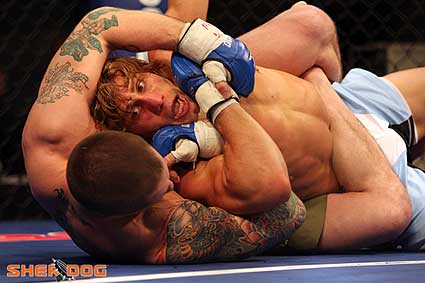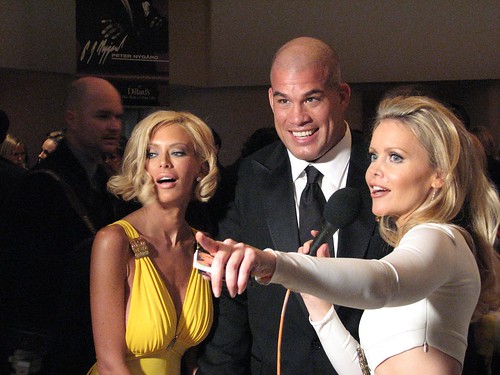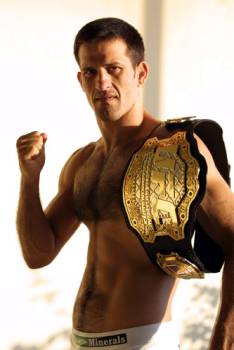
There is a specter haunting MMA…a raw, sparkly bearded, 235 pound specter named Kevin “Kimbo Slice” Ferguson, and he’s giving some people flashbacks to the mid-90’s. You remember the mid-90s, don’t you? You know, the bad old days, when MMA was more like a distilled version of the Jerry Springer Show than the professional, sanctioned athletic competition it is today. Well, maybe it wasn’t quite so bad back then, but that was how MMA was perceived in the United States. So it's understandable that fans that have stuck with the sport aren’t exactly nostalgic for the last decade of the 20th Century.
Last Saturday’s EliteXC bout has brought up the traumatic childhood of modern MMA in part due to Kimbo’s opponent: the generously proportioned David “Tank” Abbott, one of the sport’s pioneers in the U.S. The UFC’s early promoters billed Abbott as a “pit fighter” with a “500 pound jackhammer” of a right hand and an alleged history of street-fighting success. Abbott’s brutal knockouts and hops-and-barley-based training regimen are the stuff of legend, and “legend” is exactly how some of MMA’s contemporary cheerleaders would like him to remain.
Slice has been compared to Abbott, primarily because both were known as street fighters before making the transition to professional competition. Kimbo fighting Abbott was supposed to be the old versus the new, the internet-age street brawler versus the slugger of yesteryear. It made for a compelling storyline, even if the fight itself was, as many had expected, brief and lackluster.
But there are important differences between the two men, differences that reflect the large-scale changes that have reshaped the sport in the last decade and a half. When Abbott entered the UFC, he trained and fought the same way he had as an amateur, which is to say without professional guidance and a game plan that can be witnessed in most American schoolyards.
Upon signing a professional contract, Kimbo, made famous by YouTube videos filmed in various Miami-area backyards featuring the dislodged eyeballs and gushing noses of his unfortunate opponents, took up training with Bas Rutten, a legendary fighter in his own right and a widely respected trainer. According to Rutten, Slice has been a workaholic in training, spending long hours in the gym humbly absorbing the fighting wisdom of his Dutch sensei. Slice’s chiseled physique, impressive at the relatively advanced (for a professional athlete) age of 34, provided a stark contrast to the corpulent Abbott, who just barely made the heavyweight weight limit of 265 pounds.
So why have MMA message boards been alight since Saturday with shrill warnings of impending doom? Why does a bald man with stylized chest hair inspire such fear in the MMA faithful? Part of it is undoubtedly the way the fight was promoted. Gary Shaw, EliteXC’s histrionic president, took the street-fighting angle and ran with it, naming the event “EliteXC Presents: Street Certified,” with the words “presents” and “street certified” scrawled in faux graffiti, as though a millionaire boxing promoter had decided to stage this particular event inside a circle of parked cars.
MMA has struggled mightily for acceptance in the mainstream sports world, and with the sting of Sen. John McCain’s 1998 “human cockfighting” comment still lodged in their collective memory, many fans are maternally protective of the sport’s image. Some view such lowbrow appeals as a threat to the sport, not just a throw back to a darker age, but a step down the path to extinction.
Such fears may be exaggerated, but they are the fears of a fiercely devoted fan base, a population segment that will not easily be convinced that a gold-toothed street mauler is good for their beloved sport.
Despite the hype of promoters and the anxiety of some fans, Kimbo himself has shown a fairly high degree of respect for the sport, modestly acknowledging his need for professional training and refusing to guarantee immediate success. Unlike Brock Lesnar, another MMA newcomer who has fans’ nervous about the public’s perception, Slice never claimed that he would make quick work of a former UFC champion, as Lesnar misguidedly implied in his comments on Frank Mir. Slice has made such quick work of his first three opponents, some have even criticized Gary Shaw for failing to pit his muscle-bound meal ticket against stiffer competition. With only two professional fights and one exhibition to Slice’s name, Shaw can hardly be faulted for bringing him along against less than all-world competition.
But after walking through Abbott, fans may begin clamoring for Slice to face higher quality fighters. Fortunately, Shaw can draw from a decent stable of heavyweights in EliteXC and its partner promotion Strikeforce, making it likely that Slice will face a series of legitimately challenging, and entertaining, tests in the near future.
The interest generated by Slice, and Lesnar, should not be a cause for concern for serious MMA fans. The sport is growing exponentially, but in order for it to be sustainable there must be multiple points of entry to MMA fandom. Many of the fans that have been with the sport for years came to it through traditional martial arts, a relatively restricted group compared to say, fans of professional wrestling and internet gross-out videos. It’s easy to dismiss the hype surrounding Slice as the excesses of a short-sighted promoter, but it would be a mistake to dismiss the fans drawn in by it as well.
 Since its purchase by Zuffa in December of 2006, the WEC has become a legitimately solid fight promotion. Zuffa made the prescient decision to continuing operating the organization as a separate entity with its own roster of fighters and independent matchmaking, primarily to serve as a vehicle for the fighters whose contracts it acquired from the purchase of the World Fighting Alliance, including current UFC light heavyweight champion Quinton "Rampage" Jackson and Urijah Faber. Why that happy fate befell the WEC and not the similarly purchased, and inarguably stronger, PRIDE Fighting Championships is open to debate, but the fact is that PRIDE was shuttered while the WEC has thrived under the ownership of the Fertitta brothers.
Since its purchase by Zuffa in December of 2006, the WEC has become a legitimately solid fight promotion. Zuffa made the prescient decision to continuing operating the organization as a separate entity with its own roster of fighters and independent matchmaking, primarily to serve as a vehicle for the fighters whose contracts it acquired from the purchase of the World Fighting Alliance, including current UFC light heavyweight champion Quinton "Rampage" Jackson and Urijah Faber. Why that happy fate befell the WEC and not the similarly purchased, and inarguably stronger, PRIDE Fighting Championships is open to debate, but the fact is that PRIDE was shuttered while the WEC has thrived under the ownership of the Fertitta brothers.




















